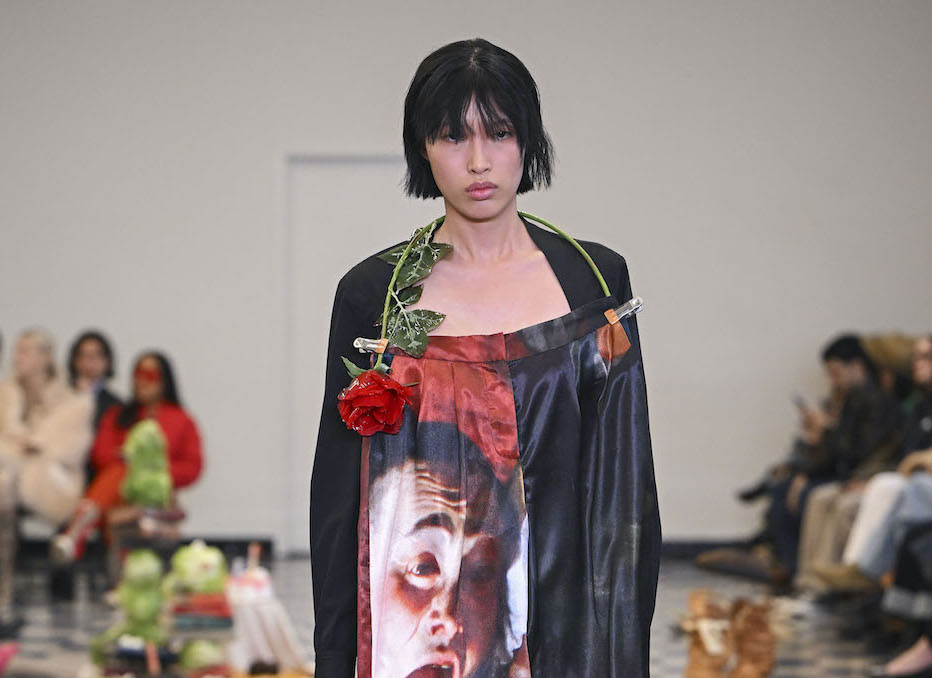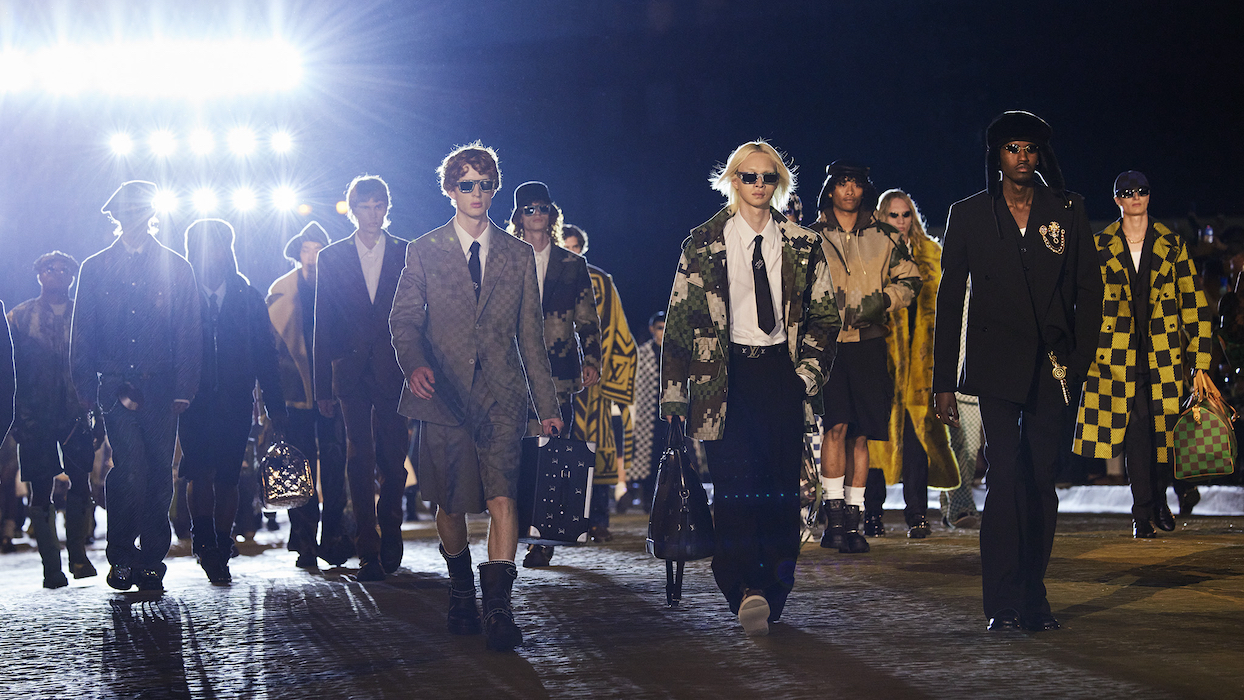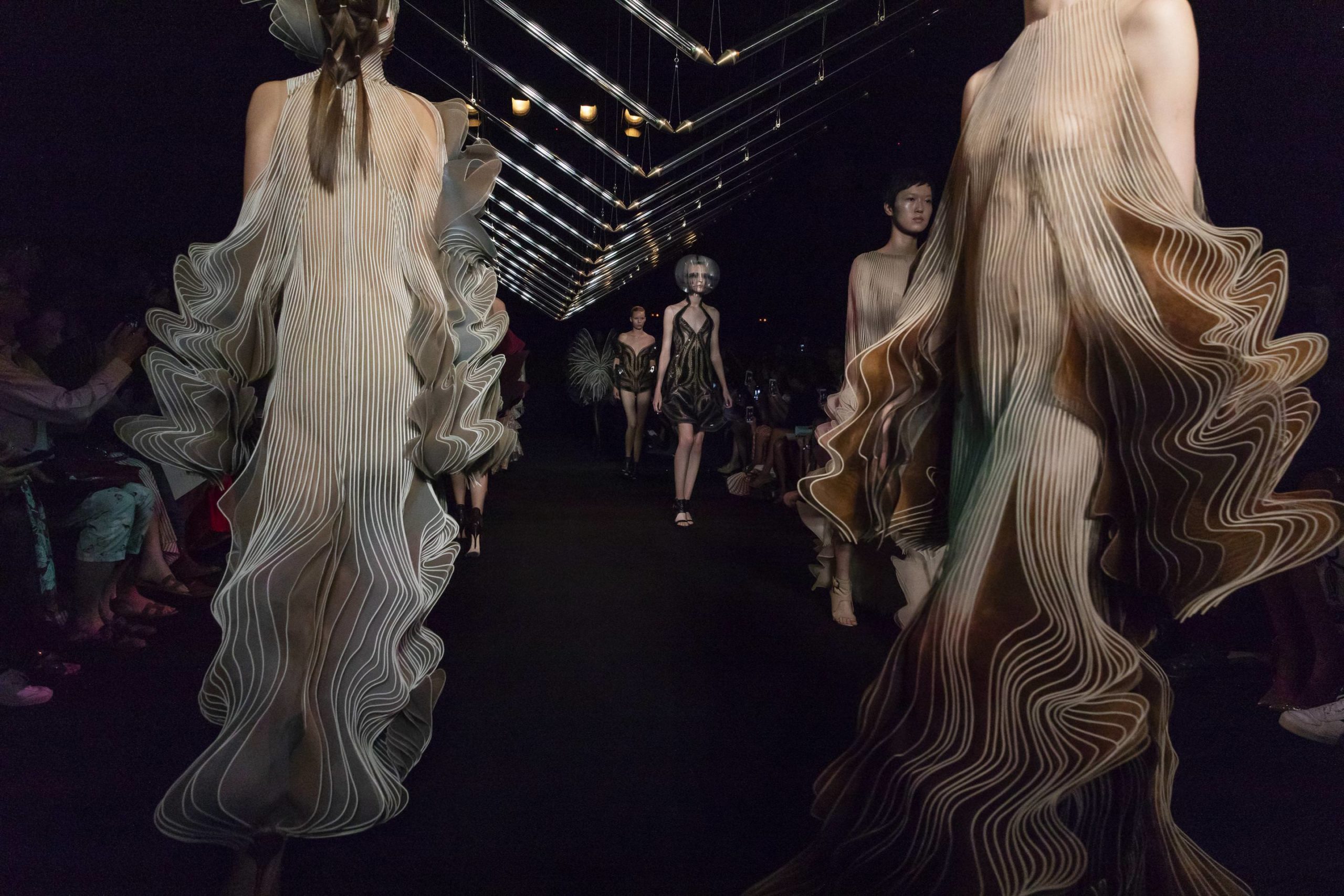Carly Mark Founded Puppets & Puppets in 2018
A love of food, film, and storytelling led Carly Mark from a start in art to a career in fashion. After graduating from the School of Visual Arts and working at Gavin Brown’s Enterprise, she began showing her trompe l’oeil paintings of Haribo gummy bear bags in exhibitions around the world. Plastic snack bags bought from the bodega were reimagined on canvas in hyperrealistic life-like size and color, tricking the eye and rousing viewers. In 2018, she decided to parlay her interests of quirky visuals from art to fashion and founded a brand. It was then that Puppets & Puppets was born.
The label was formed just before the COVID-19 pandemic, so its reaction to changing demands in customer aesthetics has naturally evolved. Styles have moved from rebellious to stay-at-home cozy, and now ultra-sexy, all in under five years. Even so, the voice of the New York–based ready-to-wear and accessories brand has remained the same. Its cool, downtown Manhattan attitude is anchored in touchpoints of grit, glamour, and humor, offering something for everyone who’s in on the joke.
Recognized for subverting fashion’s seriousness and bringing playfulness into sartorial design, accessories, and clothes, Puppets & Puppets creates pieces that are unusual and amusing. Rather than staying loyal to traditional codes of evening bags, for instance, the brand features cookies in place of logos and telephones instead of handles. Garments—from dresses and blazers to bodysuits and trousers—are imbued with a sense of timelessness, sculptural structure, and on-brand rhythm. Shapes and silhouettes are altered through unique details like asymmetrical cuts, and cutouts at the elbow, hip, and thigh.
Timed to the release of the brand’s Fall/Winter 2023 collection inspired by the film Dead Ringers, Whitewall spoke with Mark about the beginnings of Puppets & Puppets and how New York, art, film, and food continue to excite her.
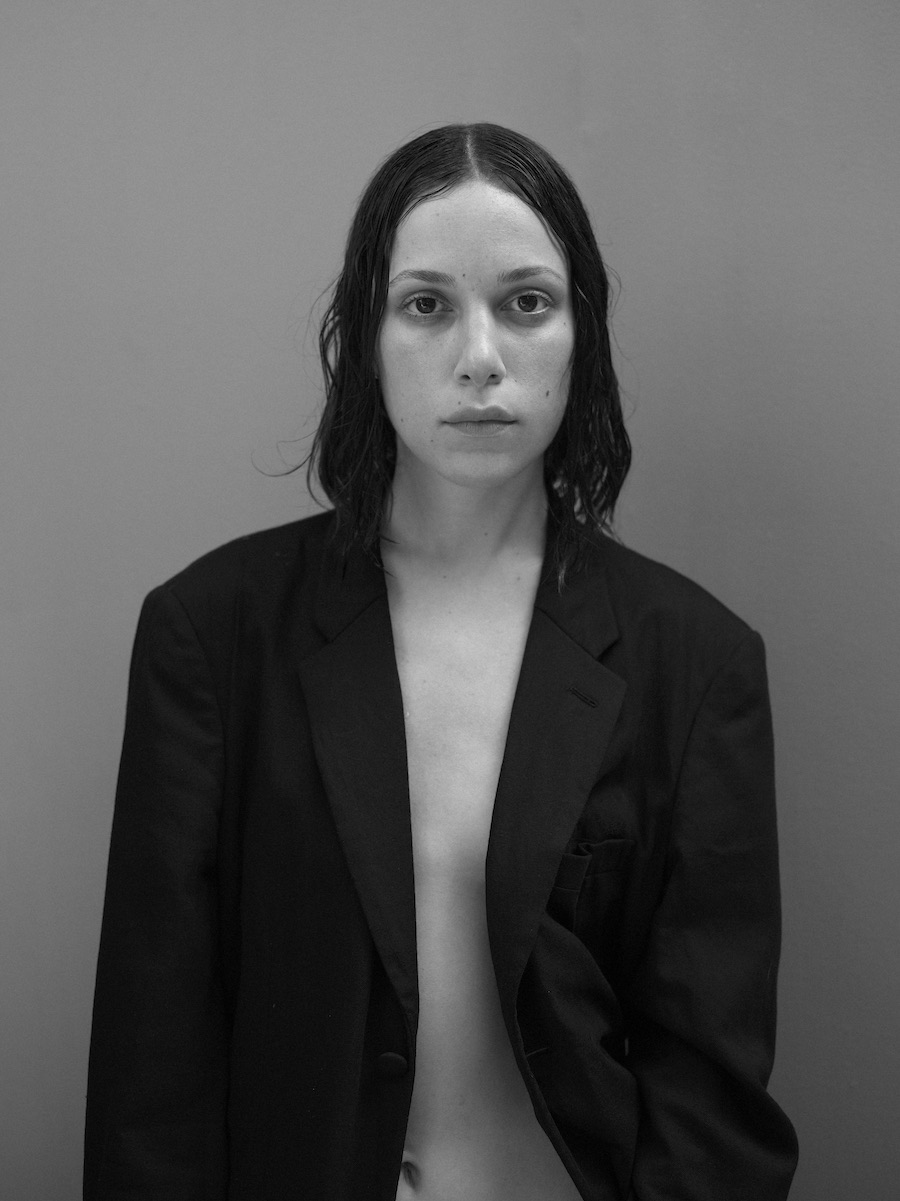
Carly Mark, portrait courtesy of Puppets & Puppets.
Moving from a start in art to fashion
WHITEWALL: Before fashion, you were immersed in the world of contemporary art. How did your career take shape?
CARLY MARK: My mother works at the Detroit Institute of Art, and she’s always talked to me about art. Before I moved to New York and was interested in art, I was interested in fashion. My mother always said, “You’re going to move to New York and be a fashion designer!” The summer before my senior year of high school, I did a summer program at Parsons. I thought I’d get there and be like, “My place!” Instead, I got there and was like, “This place is scary. Fashion is scary. Everything’s scary.” I was a creative, emotional young girl, so I thought maybe I’d make fine art my outlet. It felt like a holy thing.
I moved to New York and went to the School of Visual Arts for an undergrad degree in fine art, painting specifically. By graduation, I was making sculptures and videos, and so on. I was making my own work, showing at fairs, selling it, and started booking solo shows.
When I turned 30, I thought about the reason I went into fine art as opposed to fashion. After working in art for 10 years, I realized it was just a business and artists make product. That is totally fine, but that’s not why I did it in the first place. So I was like, “Okay, I’m going to try something else. I’m not going to go full steam ahead if this isn’t really doing it for me.”
In my mind, there were three roads that I could take. One was directing, because I love film. One was fashion design, because I had a background in that, and I loved clothes. And another, which I eventually think I still will do, is be the next Jim Henson and open a Creature Shop.
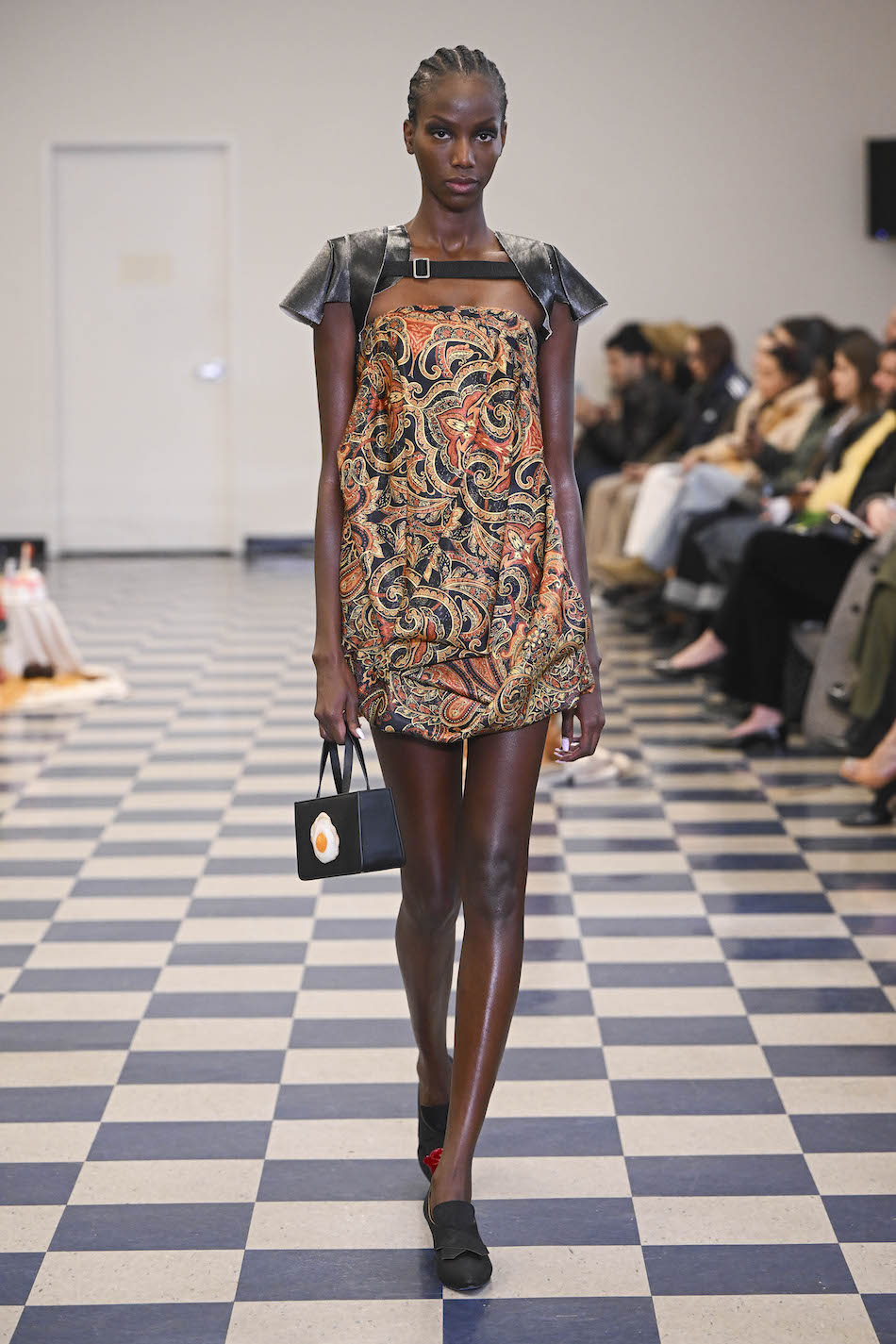
Fall/Winter 2023, courtesy of Puppets & Puppets.
WW: Why did you choose fashion and not film or the Creature Shop?
CM: Fashion was the first road I tried, and it worked. I’m not trained in fashion, in making clothes. I still don’t know how to sew. But I just viscerally knew what I wanted, and I saw a gap in New York fashion, specifically, where I would fit.
I don’t care about the same fashion rules that other people do, and I think because I’m not classically trained and I don’t have knowledge in garment construction, nothing is out of bounds for me. I always say there’s no way for me to do anything wrong because I don’t know what I’m actually doing. It’s just snowballed from there.
WW: What was that gap in the market?
CM: I felt there was a lack of ridiculousness and exuberance in New York fashion. I loved John Galliano’s Dior. And I didn’t see anyone else at the time doing that in New York. There are amazing young designers working in New York, and I’m adjacent to and friends with them. I was walking in shows and experiencing their shows, and they were so exciting and amazing, but I knew I had an “other” perspective. I was super interested in costuming and characters, fashion as sculpture, and theatricality. All of these things weren’t happening. I thought, “Not only can I do this, but I can do this differently.” And I was right.
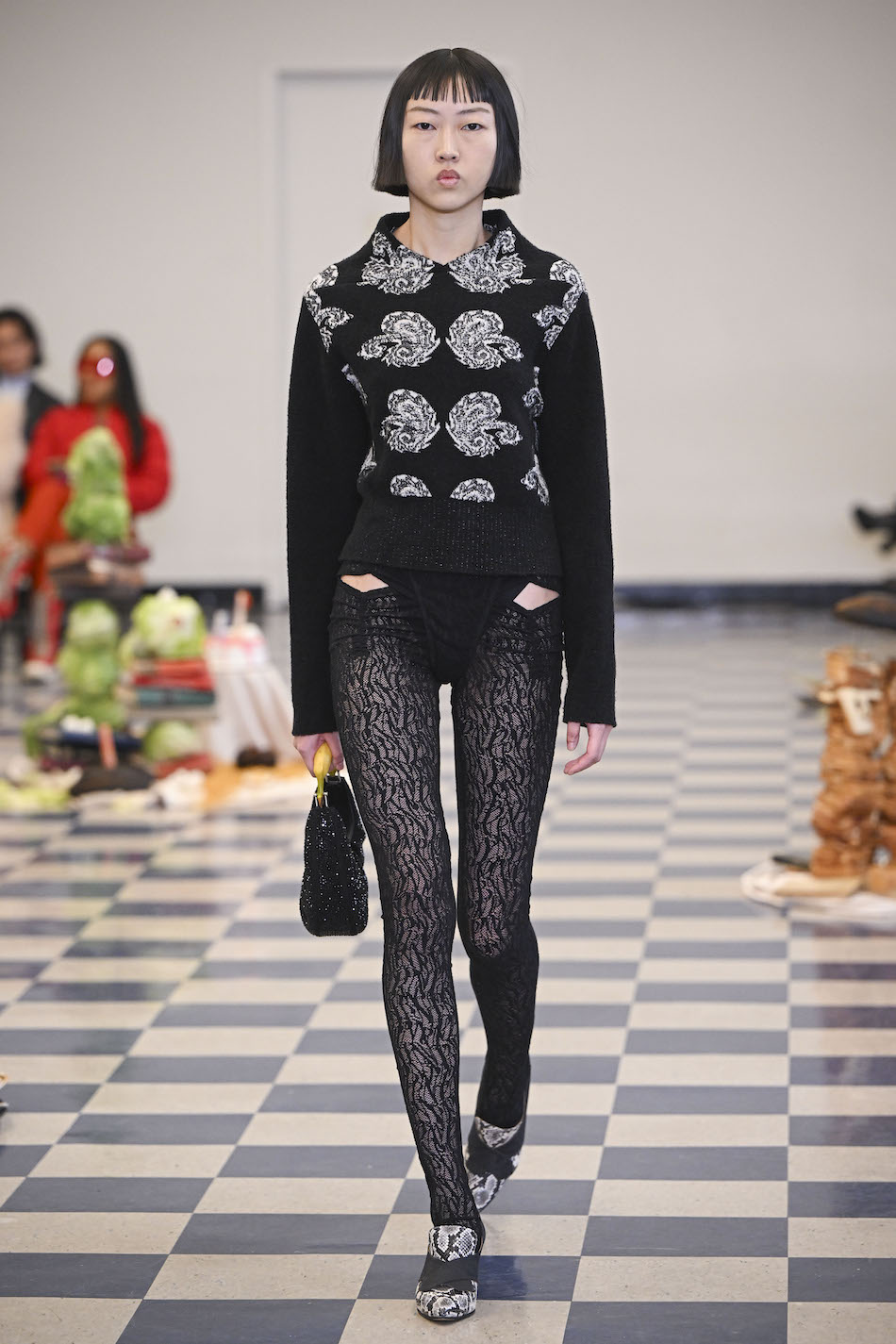
Fall/Winter 2023, courtesy of Puppets & Puppets.
Beautiful tensions provide inspiration
WW: Your work in art, focused on self-augmentation and hyperreality and seen through the Haribo gummy bear, was a mash-up of worlds you peeked into—like bodega food, the social media landscape society grew into, the ways people were acting online versus real life. Are the brand’s cookie, egg, and banana bags or belts on the same thread, mashing up contrasting worlds?
CM: Yeah, absolutely. The reason I included a cookie on a belt buckle in my third season, the first time anyone had seen it, was because I was thinking, “There’s supposed to be a belt buckle here, let’s do something else.” It’s the same splicing of universes. And I like food. That’s why I did Haribo snack bag paintings. I like food branding and I like comfort foods.
But it’s not just that. It’s also the idea of one for one. Something seductive about the Haribo bag paintings was that they were the same size as a Haribo bag. They were realistic. People thought I just framed a Haribo bag. That one for one is what makes the work really strong. It’s confusing. It’s a trompe l’oeil situation. It also touches on uncanny valley stuff, too. Whenever someone’s mind is momentarily tricked, but then it clicks into reality, and you realize what’s in front of you, it makes you question the thing. Even if it’s mundane like a banana, suddenly all you’re thinking about is bananas.
WW: Do you think it also says something about what it means to be a label today?
CM: Yes. The cookie bag is the perfect example. It’s supposed to make you laugh and smile. It’s seductive but confusing, but it’s talking about logos. In doing so, with its popularity, it has actually become my logo. It’s a very meta thing, which I think is very reflective of the times. This all makes me think of the Allegory of the Cave, looking at the reflection of a thing on a cave wall. But by being so hyper, it’s bringing you back into reality. It’s a thing that stirs you, which I love.
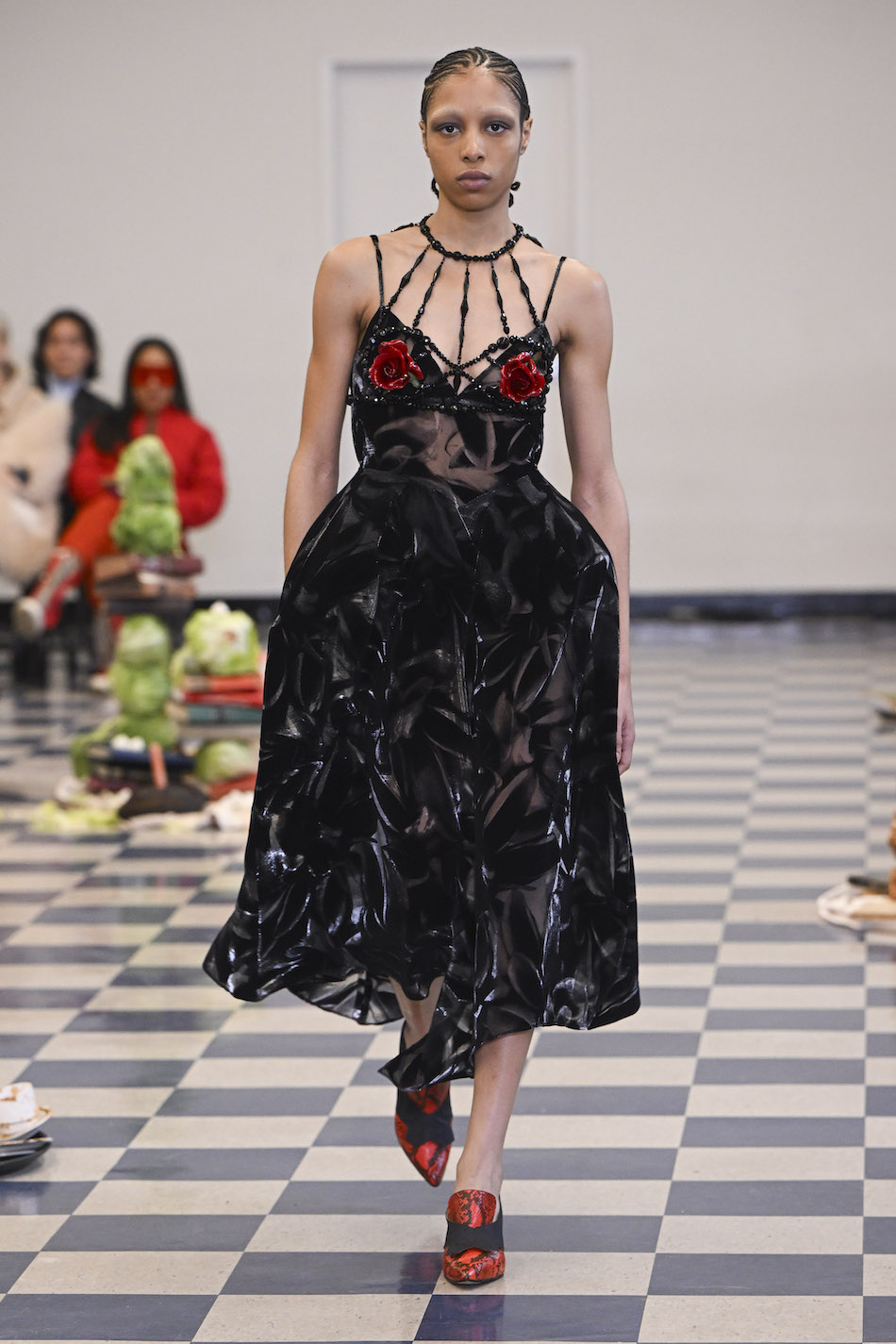
Fall/Winter 2023, courtesy of Puppets & Puppets.
Establishing a fashion brand pre-COVID19
WW: You founded Puppets and Puppets just before the COVID-19 pandemic. How did that time impact how you thought about fashion? The brand’s beginnings?
CM: I got lucky because the season right before the pandemic was my last season that I wasn’t in production. I knew that it was going to be the last season before I went into production, which is why the third season is the strangest of all my seasons. I thought, “Go big or go home.” I wanted to do this strange costuming season based on this French science fiction cartoonist that I love. There was nothing in production when the pandemic hit. I wasn’t losing orders or losing spending money on development that didn’t go into sales. The show was what it was and the season after was the season I was going to figure out how to actually produce clothes.
The pandemic hit and I said, “I’m skipping a season because I don’t feel like it’s appropriate to put out clothes when people are dying.” It didn’t feel right. So, I skipped that season and spent an entire year learning how to make clothes. I was at my family’s house in Michigan, sitting in front of the fire, picking up the phone and calling everyone that I worked with and baby-stepping our way to production. That’s the first collection, a look book that I shot with Jody Rojac, not a show, coming out of the pandemic—FW21. That was my first season in production.
The pandemic allowed me a lot of time to baby step my way through something that was incredibly foreign to me. There also was this desire for comfort during the pandemic, when the sweatpants sales flew. That was the first season I started working in knitwear. It was a perfect time because everyone was looking for comfort objects. I hit a few good strides that correlated to where we were at mentally during the pandemic.
But it’s changed so much since then. People have since gone in the opposite direction. Now everyone wants to look sexy. There’s this hyper-sexuality going on in fashion and in the world, and it’s because we were locked up for years. We felt like we lost those years. There were personal parts that were very difficult, of course, but from a business perspective, it was a time to take my time. I don’t have the luxury of that anymore, so I’m grateful for that time.
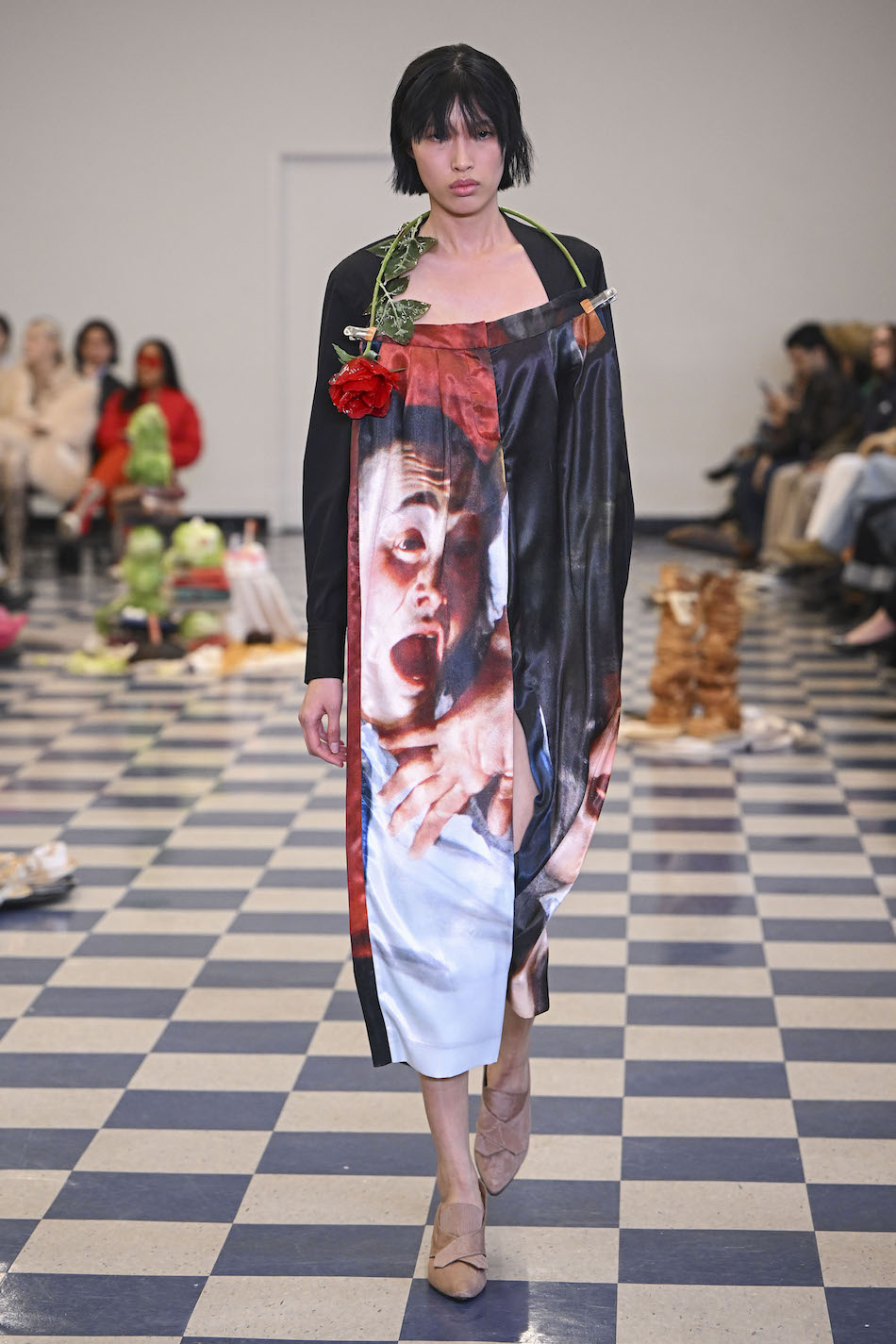
Fall/Winter 2023, courtesy of Puppets & Puppets.
WW: Many of your shapes, silhouettes, embellishments, prints, and adornments tell a story. How important is storytelling to the brand?
CM: Storytelling is incredibly important to me. At the end of the day, that’s what this all is—making things that tell a story. And it’s coming from the artist’s perspective, so particularly your story. I love films—they’re oftentimes a departure point for me—and I love them because they’re telling a story. It’s a little moment of escapism. A reprieve, a break from life. You get to see the world through another person’s eyes. But it’s still your eyes, and it’s still being reflected back at you.
I’m just like any other artist, making self-portrait after self-portrait. It should be that way, because when it’s that way, it’s honest. And I can tell you from a few seasons of sales what buyers and customers are responsive to. It’s honesty.
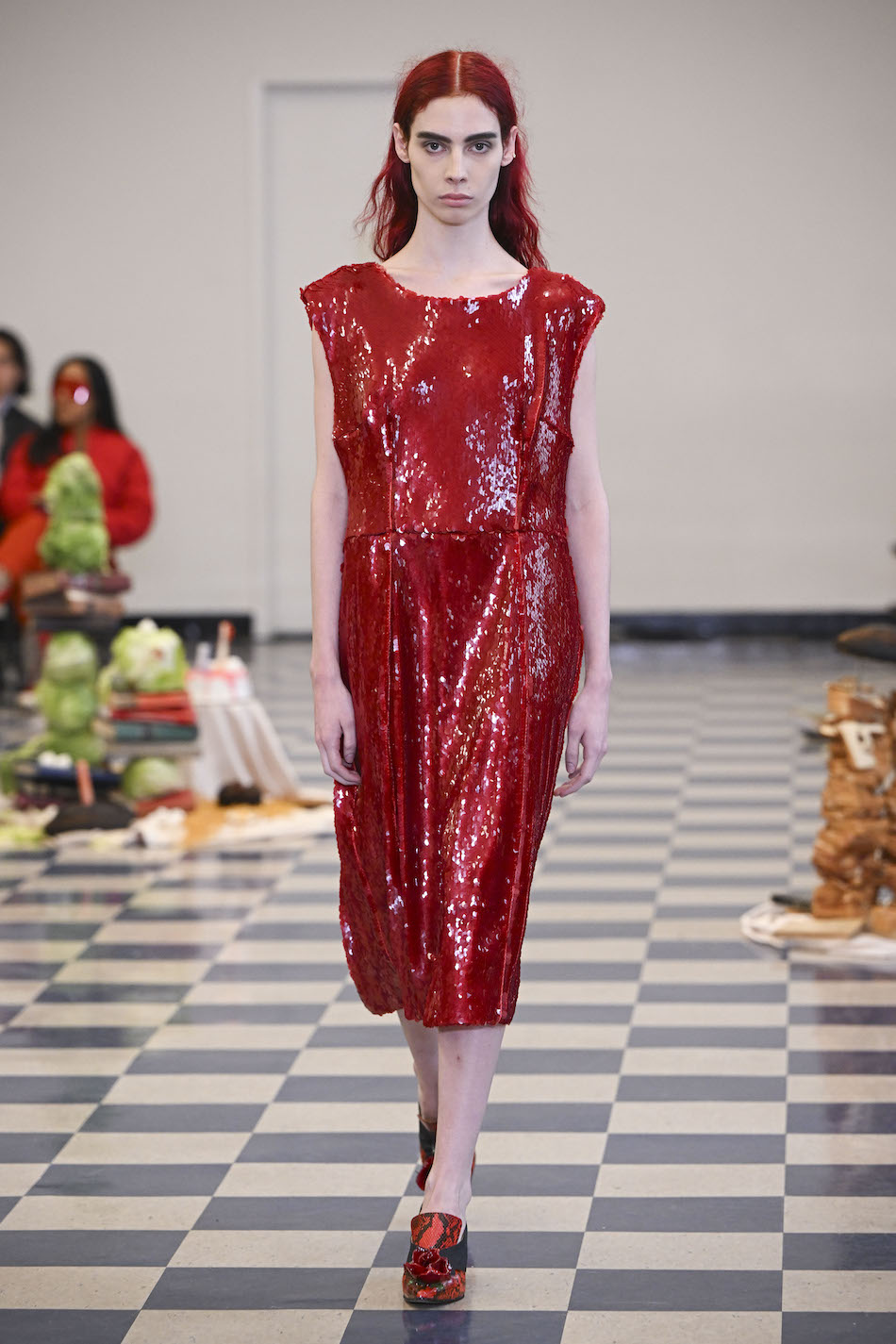
Fall/Winter 2023, courtesy of Puppets & Puppets.
Puppets & Puppets fashion strikes balance
WW: Puppets & Puppets balances comfort and utility each season. Why does it seek this
particular balance?
CW: This is the result of the fact that I’m a New York City girl. I want to look cool and hot, but I
gotta get places. I don’t dress fussy. I might dress hot, but it’s not fussy. If something feels fussy,
I can’t do it. During fittings, I think, “That’s too complicated. I won’t want to throw that in a bag
when I’m at a meeting.” We have to pare it down and make it easy. I think that’s a very
American perspective, and specifically, a very New York City perspective. How can I get there
looking good, with my feet not hurting, sit down, and then run around until the sun comes up?
WW: Your Fall/Winter 2023 collection was based on David Cronenberg’s film Dead Ringers.
Why?
CM: This was before I knew there was a Rachel Vice reboot show happening! Again, I love
having film as a jumping-off point. I love Cronenberg because he’s this perfect mix of
psychological horror and strangeness. I almost see him as a sculptor. In his movies—like
Existenz or Crimes of the Future—there are all these bodily sculptural elements that I think are
very beautiful. I have an affinity for sculpture!
Dead Ringers has a lot of red in it, so I included a lot of red in the runway show. And
there’s a lot of suiting, which I’ve always been really interested in. I love the mix of something
that feels very masculine and feminine. I also feel like that’s very American.
Since my second collection, I’ve included boning in garments, so there’s a lot of cool
structured pieces, too. Over the past few years, I’ve tried to make sure it’s part of the actual
structure of the garment—really in there. There are great wool dresses that have bones, and sheer
fabric on those panels so you also get the sexiness. I’m really into the sexiness of clothes right
now, just like everyone else.
There’s also a really beautiful print based on this painting of an operation happening.
Dead Ringers was about a set of twin gynecologists, so I was really interested in the medical
aspect of that film. I wanted to find some classical medical paintings. I always used fabrics or
patterns that have some type of painting reference, because that’s my history.
And then other sculptural elements—the banana handles, the telephone handles. I’ll
probably always do the sculpture thing, but I was wondering where else we could go other than
food. For Dead Ringers, that was a phone handle. The collection’s dark and kind of sexy,
somewhere between masculine and feminine, and it’s cool.

Fall/Winter 2023, courtesy of Puppets & Puppets.
Carly Mark’s art collection
WW: What do you have at home art-wise? Is it on theme with your personal practice and
interests in things like film, fashion, and food?
CM: Yes, I sleep with an alien movie poster above my bed, as well as a Pumpkin Head movie
poster. I have a big H.R. Giger biomechanical print next to my bed. On the other side, there’s a
beautiful artwork by my friend, Fin Simonetti, who’s a New York artist. Next to my bed I also
have a hilarious painting of a dog that I bought on eBay that was painted at the turn of the
century. In my living room, I have an amazing football painting of the Miami Dolphins by the
artist Christopher Knowles, who used to show at Gavin Brown’s Enterprise. I’m a major fan.
I also have a painting by my friend Chloe Wise of her Siamese cats. I love creatures, so I
always get animal paintings when I can. My newest piece is a drawing from Queer Thoughts Gallery by
David Rapinoe, who I’ve been a major fan of for a very long time. That’s the Carl terrain.
WW: One more question. You still don’t know how to sew. Do you feel like that’s powerful?
CM: It’s very powerful. Any time anyone has asked if I want to learn, I say no. It gives me so
much space between the thing being made and myself. With that space comes clarity. There are
no rules or limitations. Nothing is a no. When someone tells me something can’t be done, I say,
“We’re floating on a rock in outer space, just do it.” And they figure out how to do it.
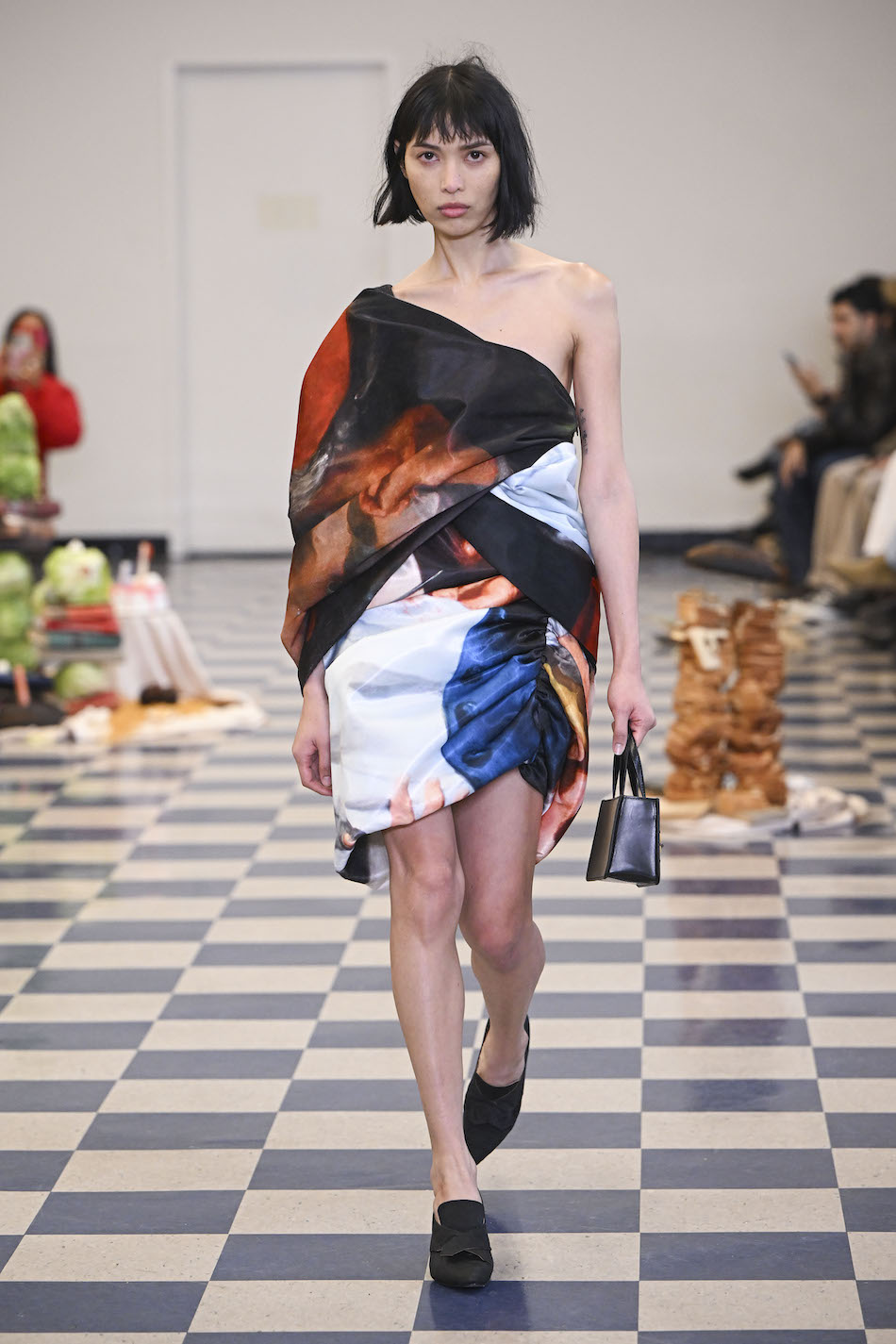
Fall/Winter 2023, courtesy of Puppets & Puppets.



